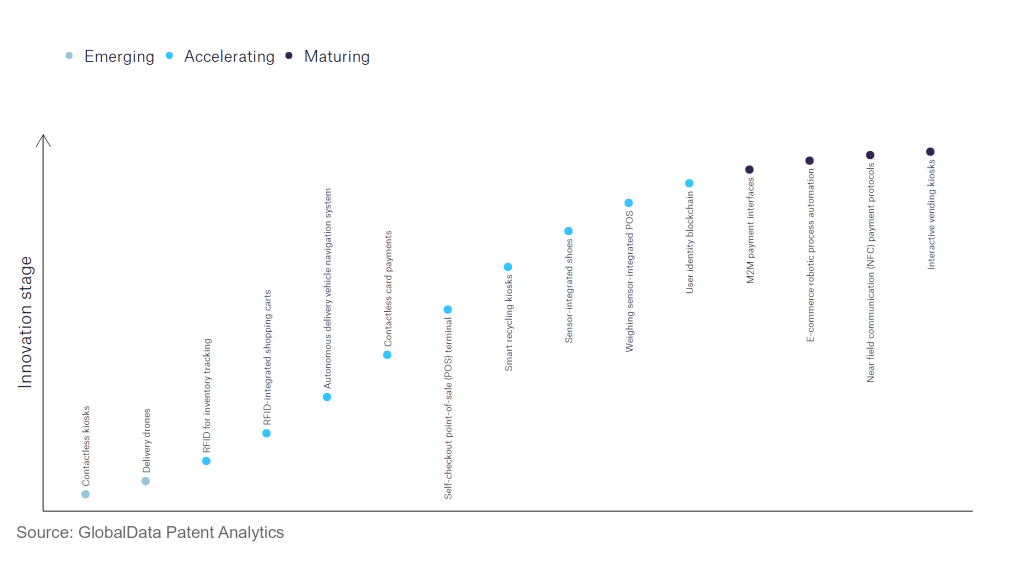The retail industry continues to be a hotbed of innovation, with activity driven by supply chain management, risk mitigation, and the growing importance of technologies such as robotic inventory and smart checkout. In the last three years alone, there have been over 133,000 patents filed and granted in the retail industry, according to GlobalData’s report on Internet of Things in Retail: NFC payment protocols. Buy the report here.
However, not all innovations are equal and nor do they follow a constant upward trend. Instead, their evolution takes the form of an S-shaped curve that reflects their typical lifecycle from early emergence to accelerating adoption, before finally stabilising and reaching maturity.
Identifying where a particular innovation is on this journey, especially those that are in the emerging and accelerating stages, is essential for understanding their current level of adoption and the likely future trajectory and impact they will have.
70+ innovations will shape the retail industry
According to GlobalData’s Technology Foresights, which plots the S-curve for the retail industry using innovation intensity models built on over 128,000 patents, there are 70+ innovation areas that will shape the future of the industry.
Within the emerging innovation stage, contactless kiosks and delivery drones are disruptive technologies that are in the early stages of application and should be tracked closely. RFID for inventory tracking, autonomous delivery vehicle navigation system, and contactless card payments are some of the accelerating innovation areas, where adoption has been steadily increasing. Among maturing innovation areas are M2M payment interfaces and e-commerce robotic process automation, which are now well established in the industry.
Innovation S-curve for Internet of Things in the retail industry

NFC payment protocol is a key innovation area in Internet of Things
Near-field communication (NFC) payments or contactless payments are different from other types of mobile payment options. They involve wireless data exchange between two devices placed in close proximity for the transaction. The payments are usually made using credit and debit cards, key fobs, smart cards, and other items to make secure purchases using NFC.
GlobalData’s analysis also uncovers the companies at the forefront of each innovation area and assesses the potential reach and impact of their patenting activity across different applications and geographies. According to GlobalData, there are 60 companies, spanning technology vendors, established retail companies, and up-and-coming start-ups engaged in the development and application of NFC payment protocols.
Key players in NFC payment protocols – a disruptive innovation in the retail industry
‘Application diversity’ measures the number of different applications identified for each relevant patent and broadly splits companies into either ‘niche’ or ‘diversified’ innovators.
‘Geographic reach’ refers to the number of different countries each relevant patent is registered in and reflects the breadth of geographic application intended, ranging from ‘global’ to ‘local’.
Patent volumes related to NFC payment protocols
Source: GlobalData Patent Analytics
The leading patent filers in the NFC payment protocols space include Samsung Group, Capital One Financial, Huawei Investment & Holding, and Blaze Mobile. Samsung Group’s ‘Samsung Pay’ makes it easier for consumers to pay using their smartphones where a conventional credit or debit card would normally be used. To make a contactless payment, a user simply needs to tap their smartwatch or smartphone.
Apple, Allegion, Syndefense, and British American Tobacco are the top companies, in terms of application diversity.
In terms of geographic reach, ViVOtech, Princo Corporation, INSIDE Contactless, and The Cauldron London.
NFC payments are dynamically encrypted, essentially making it one of the safest methods of payment. They are much faster than cash and take a tiny fraction of the time that a magnetic strip card or a chip card transaction takes.
To further understand the key themes and technologies disrupting the retail industry, access GlobalData’s latest thematic research report on Internet of Things (IoT) in Retail and Apparel.
Data Insights
From

The gold standard of business intelligence.
Blending expert knowledge with cutting-edge technology, GlobalData’s unrivalled proprietary data will enable you to decode what’s happening in your market. You can make better informed decisions and gain a future-proof advantage over your competitors.



